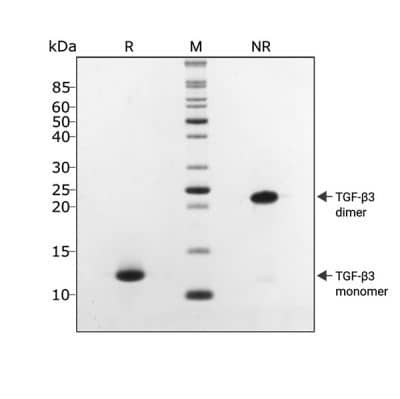Recombinant Human TGF-beta 3, Animal-Free Protein
R&D Systems, part of Bio-Techne | Catalog # Qk054

Key Product Details
Product Specifications
Source
Purity
Endotoxin Level
Predicted Molecular Mass
SDS-PAGE
Activity
Mycoplasma
Scientific Data Images for Recombinant Human TGF-beta 3, Animal-Free Protein
Recombinant Human TGF-beta 3, Animal-Free Protein Bioactivity
TGF-beta 3 activity is determined using a TGF-beta 3-responsive firefly luciferase reporter in HEK293T cells. Cells are treated in triplicate with a serial dilution of TGF-beta 3 for 6 hours. Firefly luciferase activity is measured and normalized to the control Renilla luciferase activity. EC50 = 50 pg/ml (1.97 pM).Recombinant Human TGF-beta 3, Animal-Free Protein SDS-PAGE
TGF beta3 migrates as a single band at 25 kDa in non-reducing (NR) conditions and 13 kDa upon reduction (R). No contaminating protein bands are visible.Purified recombinant protein (3 µg) was resolved using 15% w/v SDS-PAGE in reduced (+ beta-mercaptoethanol, R) and non-reduced (NR) conditions and stained with Coomassie Brilliant Blue R250.Formulation, Preparation and Storage
Qk054
| Formulation | Lyophilized from acetonitrile/TFA |
| Reconstitution | Resuspend in 10 mM HCl at >100 µg/mL, prepare single use aliquots, add carrier protein if desired. |
| Shipping | The product is shipped lyophilized at ambient temperture, on ice blocks or dry ice. Shipping at ambient temperture does not affect the bioactivity or stability of the protein. Upon reciept, store immediately at the conditions stated below. |
| Stability & Storage | Store lyophilized protein between -20 and -80 °C until the date of expiry. Avoid freeze-thaw cycles. |
Background: TGF-beta 3
TGF-beta 3 (transforming growth factor-beta 3) is a member of a TGF-beta superfamily subgroup that is defined by their structural and functional similarities (1-5). TGF-beta 3 and its closely related proteins, TGF-beta 1 and beta2, act as cellular switches to regulate immune function, cell proliferation, and epithelial-mesenchymal transition (4, 6, 7). The non-redundant biological effects of TGF- beta3 include involvement in palatogenesis, chondrogenesis, and pulmonary development (1, 2, 7-9). Human TGF-beta 3 cDNA encodes a 412 amino acid (aa) precursor that contains a 20 aa signal peptide and a 392 aa proprotein. The proprotein is processed by a furin-like convertase to generate a 220 aa latency-associated peptide (LAP) and a 112 aa mature TGF-beta 3 (10, 11). Mature human TGF- beta3 shows 100%, 99%, and 98% aa identity with mouse/dog/horse, rat, and pig TGF- beta3, respectively. TGF-beta 3 is secreted as a latent complex. This latent form of TGF-beta 3 is activated by integrins, thrombospondin-1, plasmin, and matrix metalloproteases (12, 13). It can also be activated by extreme pH and reactive oxygen species (1-5, 12). TGF-beta 3 binds with high affinity to TGF-beta RII, a type II serine/threonine kinase receptor. This receptor then phosphorylates and activates type I serine/threonine kinase receptors, TGF- beta RI or ALK-1, to modulate transcription through Smad phosphorylation (14-16). The divergent biological effects exerted by individual TGF-beta isoforms is dependent upon the recruitment of co-receptors (TGF- beta RIII and endoglin) and the subsequent initiation of Smad-dependent or -independent signaling pathways (15, 17, 18).
References
- Barrio, M.C. et al. (2014) Cells Tissues Organs. [Epub ahead of print; PMID 24861080].
- Doetschman, T. et al. (2012) Genesis 50:59.
- Mittl, P.R. et al. (1996) Protein Sci. 5:1261.
- Sporn, M.B. (2006) Cytokine Growth Factor Rev. 17:3.
- Wahl, S.M. et al. (2006) Immunol. Rev. 213:213.
- Chang, H. et al. (2002) Endocr. Rev. 23:787.
- Dunker, N. and K. Krieglstein (2000) Eur. J. Biochem. 267:6982.
- Jin, J.Z. et al. (2014) Dev. Dyn. [Epub ahead of print; PMID 25104574].
- Tang, Q.O. et al. (2009) Expert Opin. Biol Ther. 9:689.
- Derynck, R. et al. (1988) EMBO J. 7:3737.
- Miyazono, K. et al. (1988) J. Biol. Chem. 263:6407.
- Munger, J.S. et al. (1997) Kidney Int 51:1376.
- Wipff, P.J. and B. Hinz (2008) Eur J Cell Biol 87:601.
- Cui, X.M. and C.F. Shuler (2000) Int. J. Dev. Biol. 44:397.
- de Caestecker, M. (2004) Cytokine Growth Factor Rev. 15:1.
- Nakajima, A. et al. (2007) Dev. Dyn. 236:791.
- Iwata, J. et al. (2012) J. Clin. Invest. 122:873.
- Gatza, C.E. et al. (2010) Cell. Signal. 22:1163.
Long Name
Alternate Names
Gene Symbol
UniProt
Additional TGF-beta 3 Products
Product Documents for Recombinant Human TGF-beta 3, Animal-Free Protein
Product Specific Notices for Recombinant Human TGF-beta 3, Animal-Free Protein
The above product was manufactured, tested and released by R&D System's contract manufacturer, Qkine Ltd, at 1 Murdoch House, Cambridge, UK, CB5 8HW. The product is for research use only and not for the diagnostic or theraputic use.
For research use only

